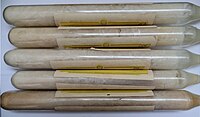Aluminium tribromide
 |
|
 |
|
| Names | |
|---|---|
|
Preferred IUPAC name
Aluminium bromide
|
|
| Other names
Aluminic bromide
Aluminium(III) bromide |
|
| Identifiers | |
|
3D model (Jmol)
|
|
| ChemSpider | |
| ECHA InfoCard | 100.028.891 |
| EC Number | 231-779-7 |
|
PubChem CID
|
|
| RTECS number | BD0350000 |
| UN number | 1725 |
|
|
|
|
| Properties | |
| AlBr3 Al2Br6 |
|
| Molar mass | 266.69 g/mol |
| Appearance | white to pale yellow crystalline solid |
| Odor | pungent |
| Density | 3.205 g/cm3 |
| Melting point | 97.8 °C (208.0 °F; 370.9 K) |
| Boiling point | 265 °C (509 °F; 538 K) |
| reacts | |
| Solubility | slightly soluble in methanol, diethyl ether, acetone |
| Structure | |
| monoclinic | |
| Hazards | |
|
EU classification (DSD) (outdated)
|
not listed |
| NFPA 704 | |
| Lethal dose or concentration (LD, LC): | |
|
LD50 (median dose)
|
1598 mg/kg (oral, rat) |
| Related compounds | |
|
Other anions
|
aluminium trichloride aluminium triiodide |
|
Other cations
|
boron tribromide |
|
Related compounds
|
iron(III) bromide |
|
Except where otherwise noted, data are given for materials in their standard state (at 25 °C [77 °F], 100 kPa).
|
|
|
|
|
| Infobox references | |
Aluminium(III) bromide
Aluminium bromide is any chemical compound with the empirical formula AlBrx. The species called "aluminium tribromide," is the most common aluminium bromide. It is a colorless, sublimable hygroscopic solid, although older samples tend to be hydrated.
The dimeric form of aluminium tribromide (Al2Br6) predominates in the solid state, solutions in noncoordinating solvents (e.g. CS2), in the melt, and the gas phase. Only at high temperatures do these dimers break up into monomers:
The species aluminium monobromide forms from the reaction of HBr with Al metal at high temperature. It disproportionates near room temperature:
This reaction is reversed at temperatures higher than 1000 °C. Aluminium monobromide has been crystallographically characterized in the form the tetrameric adduct Al4Br4(NEt3)4 (Et = C2H5). This species is electronically related to cyclobutane. Theory suggest that the diatomic aluminium monobromide condenses to a dimer and then a tetrahedral cluster Al4Br4, akin to the analogous boron compound.
Al2Br6 consists of two AlBr4 tetrahedra that share a common edge. The molecular symmetry is D2h.
The monomer AlBr3, observed only in the vapor, can be described as trigonal planar, D3h point group. The atomic hybridization of aluminium is often described as sp2. The Br-Al-Br bond angles are 120 °.
By far the most common form of aluminium bromide is Al2Br6. This species exists as hygroscopic colorless solid at standard conditions. Typical impure samples are yellowish or even red-brown due to the presence of iron-containing impurities. It is prepared by the reaction of HBr with Al:
Alternatively, the direct bromination occurs also:
Al2Br6 dissociates readily to give the strong Lewis acid, AlBr3. Regarding the tendency of Al2Br6 to dimerize, it is common for heavier main group halides to exist as aggregates larger than implied by their empirical formulae. Lighter main group halides such as boron tribromide do not show this tendency, in part due to the smaller size of the central atom.
...
Wikipedia

